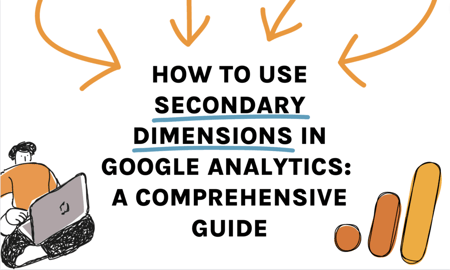Optimize Your Coverage Accuracy With Secondary Dimensions
In the world of information evaluation, the mission for precision and depth is a perpetual search. Secondary measurements offer an entrance to increasing reporting accuracy by offering a multifaceted lens whereby to view data. Envision the power of unraveling detailed layers of details that exist past the surface metrics, supplying a richer tapestry of insights waiting to be explored. As we start this trip of leveraging additional dimensions, the landscape of reporting accuracy bids with assurances of improved clarity and strategic decision-making.
Significance of Second Measurements
Making use of second dimensions is important for boosting the deepness and granularity of reporting understandings in data analysis. Additional dimensions make it possible for analysts to segment and filter data based on details standards, giving a much more personalized and targeted analysis.
Furthermore, second dimensions aid in recognizing correlations and connections that may not be immediately obvious when evaluating data with only key measurements. This much deeper level of insight can lead to even more enlightened decision-making and tactical preparation within an organization. By leveraging second dimensions effectively, companies can reveal hidden opportunities, determine locations for improvement, and optimize their overall efficiency.
Carrying Out Second Measurements
To integrate second measurements effectively into information analysis procedures, companies must adopt a structured method that aligns with their reporting goals and analytical objectives. Executing additional dimensions entails choosing the right measurements that provide much deeper understandings right into key data metrics. It is crucial to determine which second measurements will improve the understanding of the key data being examined. Services must think about factors such as the kind of data being accumulated, the specific metrics they wish to evaluate, and the essential performance indicators (KPIs) they are concentrated on boosting.
Furthermore, organizations require to guarantee that the chosen additional dimensions pertain to the key data and provide purposeful context without causing details overload. Carrying out second measurements likewise needs defining clear logical concerns that the extra measurements will help answer. By structuring the implementation process around these factors to consider, services can optimize the worth stemmed from second measurements and boost the accuracy and depth of their coverage.
Studying Data With Additional Measurements

One trick facet of assessing information with additional measurements is to guarantee that read this the chosen dimensions straighten with your certain analytical objectives. Selecting the right additional measurements can give context and subtlety to your main data metrics, allowing you to draw even more precise verdicts and make educated decisions based on the understandings acquired.
In addition, leveraging secondary dimensions successfully can aid in identifying outliers, comprehending the impact of various variables on your crucial performance indicators, and obtaining a detailed view of your information landscape. By diving into information with second dimensions, you can visit this site boost the deepness and quality of your evaluation, bring about even more robust coverage and workable end results.

Enhancing Insights Via Additional Measurements
Discovering information via second measurements not only deepens evaluation yet likewise enhances the possibility for discovering useful understandings that can dramatically boost reporting precision. By including secondary measurements to your reports, you can get an extra comprehensive understanding of the partnerships between different data factors. When assessing information with main dimensions alone., this enhanced point of view allows you to identify patterns, trends, and relationships that may have been forgotten.

Essentially, leveraging additional measurements empowers you to draw out richer insights from your information, allowing you to make even more educated choices and optimize your reporting precision.
Best Practices for Secondary Measurements
Utilizing second measurements successfully requires careful consideration of key approaches to enhance information evaluation and reporting precision. When applying second dimensions, it is necessary to align them with your primary metrics to derive significant insights. One best method is to make use of secondary dimensions moderately, focusing on those that straight add to the particular evaluation objectives. By preventing the temptation to consist of excessive measurements, you can keep clearness in your reporting and protect against information overload.
One more critical method is to try out different mixes of second and main dimensions to reveal distinct relationships and patterns within your data. This iterative method can reveal beneficial understandings that might have been neglected otherwise. Furthermore, it is very important to frequently assess and fine-tune your additional measurement selections to guarantee they continue to be pertinent and lined up with your advancing reporting needs.
In addition, documenting the reasoning behind your choice of additional measurements can offer context for future evaluation and assist in partnership within your group. By following these finest techniques, you can make best use of the performance of secondary dimensions in improving your coverage precision and driving informed decision-making.
Verdict
Incorporating additional measurements in data analysis is essential for taking full advantage of reporting precision and obtaining deeper insights into performance fads. Implementing finest techniques for second measurements improves the depth of evaluation and boosts the importance of reporting end results.
Moreover, second measurements help in recognizing correlations and visit this site connections that might not be quickly evident when evaluating data with just primary dimensions. Executing second dimensions includes choosing the best dimensions that offer much deeper understandings right into primary data metrics. Executing second dimensions additionally requires defining clear analytical concerns that the added dimensions will certainly aid respond to.When analyzing information with additional measurements, it is crucial to focus on drawing out useful insights that complement key information metrics. By integrating additional dimensions right into your evaluation, you can uncover patterns, trends, and relationships that may not be obvious when looking at the data from a primary measurement alone.